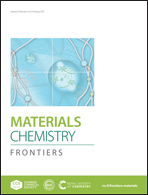Poly[N-(2-acetamidoethyl)acrylamide] supramolecular hydrogels with multiple H-bond crosslinking enable mouse brain embedding and expansion microscopy†
Abstract
Supramolecular hydrogels attract extensive attention as waterborne biocompatible materials like biological tissues. Here we developed poly[N-(2-acetamidoethyl)acrylamide] (PAAE) supramolecular hydrogels with multiple hydrogen bonds, which exhibit ideal mechanical performances, such as strong resistance to compression and stretch, high stability in acidic or high ionic strength solution, excellent waterborne adhesiveness, self-healing and swelling behaviors. The small molecular precursor for PAAE hydrogels possesses great solubility up to 70 wt% in deionized water and superior infiltration capability to mouse brain tissues at 5 °C, and can be in situ polymerized at 30–45 °C and swollen in deionized water with a 1.75 times linear expansion factor. There is no noticeable loss of fluorescence intensity during the whole process from small molecular infiltration and polymerization to expansion. The mouse brain slices were embedded and used for expansion microscopy with enhanced optical resolution and preserved structure integrity.
![Graphical abstract: Poly[N-(2-acetamidoethyl)acrylamide] supramolecular hydrogels with multiple H-bond crosslinking enable mouse brain embedding and expansion microscopy](/en/Image/Get?imageInfo.ImageType=GA&imageInfo.ImageIdentifier.ManuscriptID=D0QM00733A&imageInfo.ImageIdentifier.Year=2021)
- This article is part of the themed collection: 2020 Materials Chemistry Frontiers HOT articles


 Please wait while we load your content...
Please wait while we load your content...